PAPILIO CRESPHONTES:
THE GIANT SWALLOWTAIL
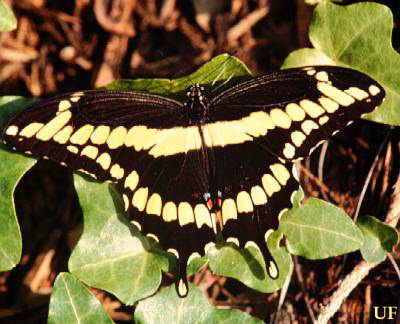 |
Although the giant swallowtail ranges across the eastern half
of the U.S. from the New England states to Florida and thence westward
across the U.S. Mexican border through California, I never saw a live one
in New Jersey.
All images and much information in this
article are taken from web pages of the University of
Florida and
Florida Department of Agriculture and Consumer Affairs:
Photographers: Heather McAuslane and James Castner |
This beautiful butterfly is
regarded
as a pest in citrus growing regions. Although the larvae do
not pose a threat
to mature, fruit bearing trees, they can completely strip the foliage from young
trees.
A single female can lay as many as five hundred
light brown or cream coloured eggs, usually singly on
the upper surfaces of outer, younger leaves. |
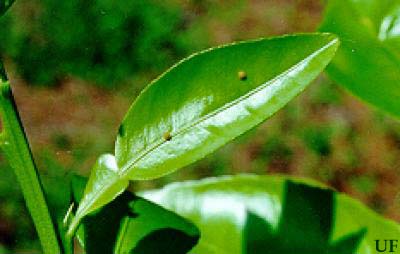 |
The eggs incubate for only a few days
before emergence of brown, white-saddled, larvae, strongly
suggesting a bird dropping. This colouration is typical of
many papilios. |
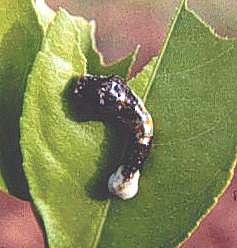 |  |
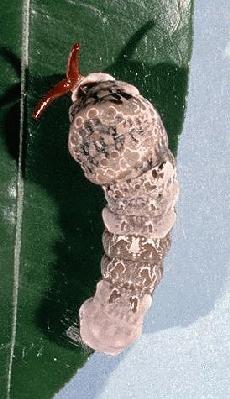 |

| In 3 weeks, larvae will pass through 5
similarly coloured instars and then fasten themselves to a twig or nearby
vertical surface and form a pupa. A disturbed, fifth instar larvae,
projects foul-smelling osmeterium in a typical papilio defense.
|
These butterflies are easily captured while nectaring on flowers or drinking
at water puddles, particularly those near manure. Captured females placed in cages or
protective sleeves will readily lay eggs on various foodplants:
Amyris elemifera, Torchweed;
Casimiroa edulis, White sapote;
Citrus species;
Dictamnus albus, Gas plant;
Ptelea trifoliata, Hop tree;
Zanthoxylum americanum, Northern prickly ash;
Z. clavahercules,
Hercules club;
Z. fagara, Wild lime prickly ash.
In the southern most extremes of its range, butterflies will triple brood,
spending only 9-12 days in the chrysalis stage for the first two broods.
The final brood overwinters as pupae.
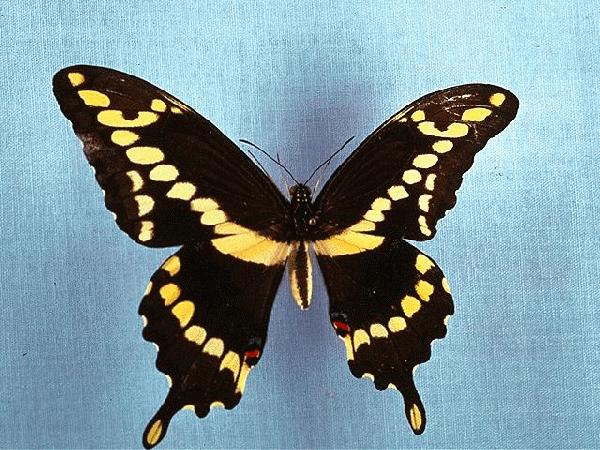
The female tends to be slightly larger than
the male. The image above appears to be of a gynandromorph where the left
side is female and the right side is male. This happens occasionally,
but is not often spotted in species where males and females have similar
wing colours and patterns.
GO TO:
|
Monarch
Viceroy
White admiral
Mourning cloak
Milbert's tortoise shell
Black swallowtail
Canadian Tiger swallowtail
Cabbage white
Question mark
Satyr comma
Red admiral
Painted lady
American painted lady
|
|
| Google is one of my favourite Search Engines and seems to offer the most
extensive listing of butterfly sites. Use your back arrow to return to this site after using the
Google search box to the left. |
To use Google most effectively, type in either the complete Latin name for the butterfly or
the complete common name followed by the word butterfly. If I wanted additional information
about the red admiral, I would type in "Vanessa atalanta" or "red admiral butterfly" and then
click on the Google Go button to the left.
Here are some additonal northeastern North American butterflies of interest.
To my knowledge, these species do not fly on Prince Edward Island, but I have reared
most of them as a boy growing up in rural New Jersey.
|
Pipevine swallowtail
Buckeye
Red-spotted purple
Giant swallowtail
Eastern Tiger swallowtail
Spicebush swallowtail
|
Visit other websites maintained by Bill Oehlke:
+++LIVESTOCK AND SUPPLIES FOR SALE***
This site is designed and
maintained
by Bill Oehlke. You can reach Bill for questions
by clicking on his name (email) or by phone 902-838-3455,
or at Bill Oehlke,
Box 476, Montague, P.E.I., Canada C0A 1R0.
I offer two membership sites that far exceed the
coverage offered
on the sites listed above:
THE WORLD'S LARGEST SATURNIIDAE SITE and
CATERPILLARS TOO!







